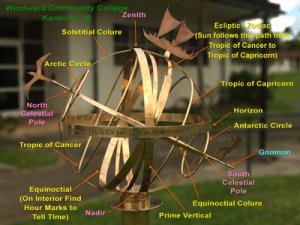Armillary Sundial
 Colure
Colure is one of two principal meridians (great circles) on the celestial sphere—equinoctial colure and solstitial colure.
•
Equinoctial colure: meridian or great circle that passes through the celestial poles and the two equinoxes (first point of Aries and first point of Libra).
•
Solstitial colure: meridian or great circle that passes through the celestial poles and the two solstices (first point of Cancer and first point of Capricorn).
Meridional (Local Meridian): upper half of the great circle that spans from the north point on the horizon to the zenith back down to the south point on the horizon. On an armillary sphere, it forms the upper half of the Solstitial Colure.
Antimeridian: lower half of the great circle that spans from the north horizon to the nadir back up to the south horizon. On an armillary sphere, it forms the lower half of the Solstitial Colure.
Equinoctial: refers to the celestial equator. The term equinoctial refers to the fact that the vernal and autumnal equinoxes occur when the sun passes through this great circle. The celestial equator is a projector of the earth’s equator onto the celestial sphere. The hour markings of the armillary sundial are inscribed on the inner surface of this ring.
Horizon: in astronomy, the unobstructed horizon is the circumference of the plane tangent to the earth’s surface at the observer’s location that intersects the celestial sphere. The horizon’s altitude is 0o.
Zenith: in the horizon coordinate system, it is the position directly overhead on the celestial sphere. The zenith’s altitude is 90o.
Nadir: in the horizon coordinate system, it is directly downward, diametrical opposite the zenith. The nadir’s altitude is –90o. In the modern art of geodesics, since the earth is not a sphere, but a slightly oblate spheroid, the line of nadir does not intersect with the center of the earth.
Prime Vertical: the great circle that passes through the zenith and nadir, and intersects the horizon at its east and west points.
Ecliptic: apparent path of sun on the celestial sphere. The ecliptic is the great circle formed by the intersection of the earth’s orbit projected onto the celestial sphere. The sun's path traditionally starts on the equinoctal (celestial equator) at the Vernal (Spring) Equinox. The ecliptic shows the sun's travel to the Summer Equinox, just touching the Tropic of Cancer. Then the sun travels south along the Ecliptic to the Autumnal (Fall) Equinox and further south to the Winter Solstices, just touching the Tropic of Capricorn, then "turning", the sun follows the Ecliptic back to the Spring Equinox on the Equinoctal.
Zodiac: a band 18o wide that is centered on the ecliptic. The zodiac comes from the Greek word for "circle of animals" that form the various constellation of stars in the eclilptic. The constellation of animals aries (the ram), taurus (the bull), cancer (the crab), leo (the lion), scorpius (the scorpion), and capricornus (the capricorn) were named at least a thousand years before by Babylonian and Chaldean astronomers. Since Roman times we also have constellation of libra (scales) and the representation of people in the form of aquarius (the water carrier), gemini (the twins), virgo (the virgin), and sagittarius (the archer).
Obliquity: Earth's axial tilt or obliquity of the ecliptic is defined as the angle that its rotational axis makes with its orbital plane (ecliptic). The earth’s axial tilt is currently 23o 26.2’ (23.44o). Since the earth’s orbital plane is affected by the other planets in the solar system, its axial tilt varies over time. Data over the past 5 million years show that the obliquity varies from 22.1o and 24.5o over about 41,000 years. Currently the earth’s obliquity is slowly decreasing towards the low values. There are other shorter-term variations in the obliquity, such as nutation, which is caused by the moon and varies over 18.6 years.
Tropic of Cancer: This small circle (also called the Northern Tropic) forms the northernmost latitude on earth at which the noontime sun can cross the zenith. This occurs around June 21 and is called the summer solstice in the northern hemisphere. A corresponding circle, also called the Tropic of Cancer, is formed by the projection of the earth’s Tropic of Cancer onto the celestial sphere. In ancient times, the sun passed through the zodiacal constellation of Cancer at this time of year — thus its name Cancer. The word “tropic” derives from the Greek word meaning
turn — referring to the point on the sky where the sun changes direction and begins moving south as winter approaches in the northern hemisphere. Today, while precession (the wobble of the earth on its axis) has shifted the summer solstice into the constellational of Taurus, the solstitial sun remains in the astrological sign of Cancer, which is unaffected by precession. The Tropic of Cancer is currently at latitude 23o 26.2’ N (23.44o N). Like the obliquity, the latitude of the Tropic of Cancer varies from 22.1o N and 24.5o N over about 41,000 years. The Tropic of Cancer is moving south toward the equator at about 50 feet per year.
Tropic of Capricorn: This small circle (also called the Southern Tropic) forms the southernmost latitude on earth at which the noontime sun can cross the zenith. This occurs around Dec 21 — and is called the winter solstice in the northern hemisphere. A corresponding circle, also called the Tropic of Capricorn, is formed by the projection of the earth’s Tropic of Capricorn onto the celestial sphere. In ancient times, the sun passed through the zodiacal constellation of Capricornus at this time of year — thus its name Capricorn. The word “tropic” derives from the Greek word meaning
turn — referring to the point on the sky where the sun changes direction and begins moving north as summer approaches in the northern hemisphere. Today, while precession (the wobble of the earth on its axis) has shifted the winter solstice into the constellational of Sagittarius, the solstitial sun remains in the astrological sign of Capricorn, which is unaffected by precession. The Tropic of Capricorn is currently at latitude 23o 26.2’ S (23.44° S). Like the obliquity, the latitude of the Tropic of Capricorn varies from 22.1o S and 24.5o S over about 41,000 years. The Tropic of Capricorn is moving north toward the equator at about 50 feet per year.
Arctic Circle: This small circle forms the northernmost latitude on earth at which the center of the sun’s disk travels completely around the horizon for a full 24 hours on the June solstice (summer solstice in the Northern hemisphere). Currently the latitude of the Arctic Circleis 66o 33.8’ N.The latitude of the Arctic Circlevaries from 67.9o N and 65.5o N over about 41,000 years. The Arctic Circleis moving south toward the equator at about 50 feet per year.
Antarctic Circle: This small circle forms the southernmost latitude on earth at which the center of the sun’s disk travels completely around the horizon for a full 24 hours on the December solstice (summer solstice in the Southern hemisphere). Currently the latitude of the Antarctic Circleis 66o 33.8’ S. The latitude of the Antarctic Circlevaries from 67.9o S and 65.5o S over about 41,000 years. The Antarctic Circleis moving north toward the equator at about 50 feet per year.
Gnomon:represents the earth’s rotational or polar axis. The gnomon inclines to the horizon by an angle equal to the latitude of the observer.
Meridian: a great circle running along a line of longitude—in the north-south direction.
Great Circle: a largest circle along the surface of a sphere, whose center coincides with the center of the sphere.
Small Circle: a circle along the surface of a sphere, whose center does not coincide with the center of the sphere.


